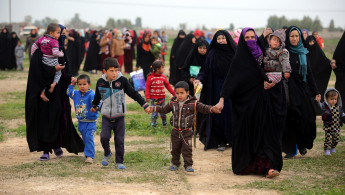Iraqis displaced from 'liberated' regions still not allowed back
The situation is similar with the displaced residents of Diyala, Salah al-Din, Beiji, Ramadi and several other towns and villages recaptured by Iraqi forces several months ago.
As the residents, many of whom live in tents and makeshift camps, wait in difficult conditions, the government has cited various pretexts for the delay.
Recently, the Tribal Commisson of the Iraqi parliament said a new plan has been put forward to return the displaced to areas liberated by the Iraqi government.
"Returning the displaced to the (liberated) regions requires huge and concerted efforts from the tribal leaders and local authorities," said the commission's chairman Abboud Issawi to The New Arab.
 |
Displaced Iraqis are being prevented from returning home by militias more than a year after IS was driven out from their areas |  |
Issawi claimed the commission is working hard to engage the tribes to resolve the crisis.
However, this and previous appeals have yet to materialise, with the Iraqi government forces still apparently stalling.
Six months after the recapture of Jurf al-Sakhar, which lies in the Babel governorate 60 km from Baghdad, military leaders had claimed no one would be allowed to return until all mines and booby traps laid down by IS in the town are removed.
At the time, the governor of Babel said the return of the displaced was contigent upon the removal of explosive devices in Jurf al-Sakhar. However, comments by the commander of Iraqi forces in Babel suggesting the town was safe triggered doubts as to the real reason why no one has been allowed to return more than a year later.
In Diyala, 57 km east of Baghdad, site of fierce fighting between IS and Iraqi forces that ended with the latter recapturing the city, most of the displaced are also yet to return.
Several committees were formed to help the residents return, but thousands of them are still living in refugee camps. Some analysts believe the real reason for the delay tactics here and elsewhere has to do with "demographic engineering".
Muthanna al-Tamimi, governor of Diyala, had announced in November 2015 a special office would be set up to follow up the affairs of the displaced with a view to return them to their homes. But nothing has changed on the ground.
 |
Nearly 3.5 million people have been displaced from Jurf al-Sakhar, Anbar, Diyala, Salah al-Din, Mosul and Baghdad |  |
Some have accused the Iraqi government of seeking demographic changes in these areas, to replace the original inhabitants with others from the Shia-majority south.
Most of these areas were retaken from IS with the help of the Iran-backed Popular Mobilisation militias, which are thought to be the main party objecting to the return of the displaced residents.
"With the villages of Azim, Saadiya..Miqdadiya and 38 other villages in Diyala governorate, only 2,000 out of 150,000 displaced families have been allowed to return," claimed Nahida al-Daini, MP from the Sunni-dominated Alliance of Iraqi Forces.
"The families that have returned all come from a specific background while others were prevented from returning," Daini said, in reference to displaced Sunni families.
Some activists and displaced residents in Babel, Diyala and Salah al-Din have corroborated the presence of sectarian motives behind the delay, saying Popular Mobilisation militias have seized the homes of the displaced for the purpose.
Nearly 3.5 million people have been displaced from Jurf al-Sakhar, Anbar, Diyala, Salah al-Din, Mosul and Baghdad as military operations began in these areas nearly two years ago.



